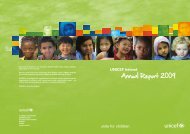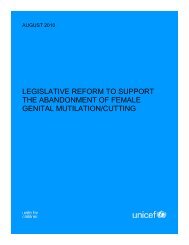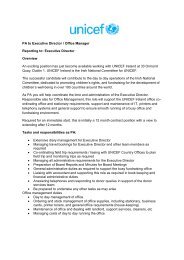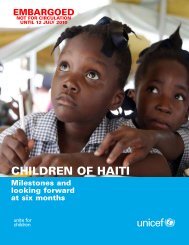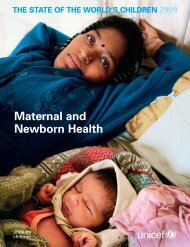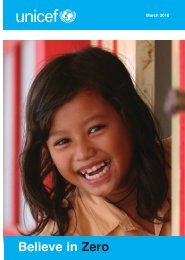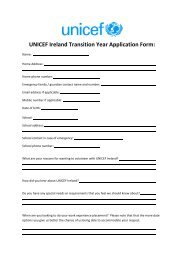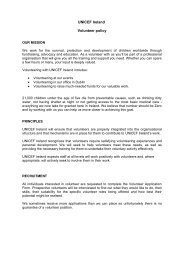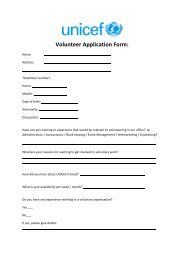Humanitarian Action for Children 2011 - Unicef
Humanitarian Action for Children 2011 - Unicef
Humanitarian Action for Children 2011 - Unicef
- No tags were found...
Create successful ePaper yourself
Turn your PDF publications into a flip-book with our unique Google optimized e-Paper software.
Yemen<strong>Children</strong> and women in crisisThe lives of Yemen’s children and women are being severely circumscribed by a complex mixof acute emergencies and chronic underdevelopment: insecurity in the Sa’ada Governoratein the north; strife in the south; displacement resulting from both; lack of food and water;significant numbers of migrants and refugees; 1 poor status of women; and flooding. At thesame time, there is minimal access to services to mitigate these conditions, such as healthcare, potable water and sanitation, education and protection, and minimal humanitarian space<strong>for</strong> outside actors to address immediate needs. Hundreds of thousands of displaced persons,70 per cent of them women and children, 2 require assistance. The communities hosting themrequire support. The protracted nature of the emergency environment in Yemen has severelytested the coping mechanisms of all who are affected.<strong>Humanitarian</strong>funding at work:Highlights from 2010In Text the mid-2010 request,UNICEF estimated thatUS$9,669,689 was needed tofund its humanitarian workin Yemen. As of October2010, a total of US$6,343,774had been received, or 66per cent of the goal. Thisfunding has enabled UNICEFto improve the prospectsof Yemeni children, as seenin some key results: Morethan 11,000 children weretreated <strong>for</strong> undernutrition in32 outpatient treatment sites;more than 46,000 internallydisplaced adults and childrenin the northern governoratesand 5,000 people from hostcommunities gained accessto safe drinking water;125,000 children in conflictaffectedgovernoratesreceived educationalopportunities; and 3,500vulnerable children weregiven psychosocial supportto overcome the traumasassociated with conflict anddisplacement.Meeting urgent needs and building resilience in <strong>2011</strong>In <strong>2011</strong>, UNICEF will continue to work with the Government of Yemen, other UN agencies, localand international NGOs as well as host communities in addressing the needs of nearly 1.2million women and children affected by conflict, including those displaced in the northern andsouthern governorates and those affected by other potential emergencies. The organizationleads the WASH, nutrition and education clusters in Yemen, as well as the child protectionsub-cluster.• <strong>Children</strong> living in displaced settlements are more vulnerable to undernutrition. Some 80,000children with severe acute malnutrition will receive life-saving treatment.• Access to better health-care services can decrease child deaths and illness. To that end, atleast 60,000 children under age 5 in Sa’ada will benefit from a full set of vaccinations.• Safe water contributes to individual and community health. At least 120,000 vulnerablepeople will benefit from one or more of the humanitarian WASH components: access tosafe water, sanitation and hygiene promotion. For example, 8,000 children will benefit fromimproved WASH facilities at 20 schools in Sa’ada and Hajjah.• Around 200,000 children affected by instability throughout the country will be able to counton a return to some <strong>for</strong>m of normalcy as they attend child-friendly learning spaces thatprovide access to quality education.• 1,600 children who have experienced violence, recruitment, detention, separation ortrafficking will receive psychosocial, medical and judicial assistance and be reintegrated intotheir communities.• UNICEF continues to address the chronic underdevelopment of the country, including chronicundernutrition, by mid- and long-term interventions through its regular programmes.Funding requirements <strong>for</strong> <strong>2011</strong>In the midst of protracted emergencies, stabilizing the welfare of women and children inYemen – particularly their nutritional status, their access to safe water, and their ability toobtain education and protection – is crucial. UNICEF is requesting US$20,294,000 to carry outits planned activities, approximately the same amount as last year. UNICEF has aligned itsrequest with the <strong>2011</strong> Consolidated Appeals Process (CAP) requirements.More in<strong>for</strong>mation on details on achievements of 2010 and the humanitarian actionplanned <strong>for</strong> Yemen in <strong>2011</strong> can be found at www.unicef.org/hac<strong>2011</strong>.1. United Nations High Commissioner <strong>for</strong> Refugees, ‘Yemen Factsheet’, UNHCR, Geneva, September 2010, p. 1.2. United Nations <strong>Children</strong>’s Fund, ‘UNICEF Yemen 2009 Annual Report’, UNICEF, Sana’a, Yemen, December 2009,p. 7.UNICEF EMERGENCY NEEDS FOR <strong>2011</strong> (in US dollars)Total $20,294,0002,151,000 Health2,969,000Child protection1,000,000Cluster coordination6,952,000 Nutrition5,145,000 WASH2,077,000Education52 <strong>2011</strong> UNICEF <strong>Humanitarian</strong> <strong>Action</strong> FOR CHILDREN | www.unicef.org/hac<strong>2011</strong>Yemen




